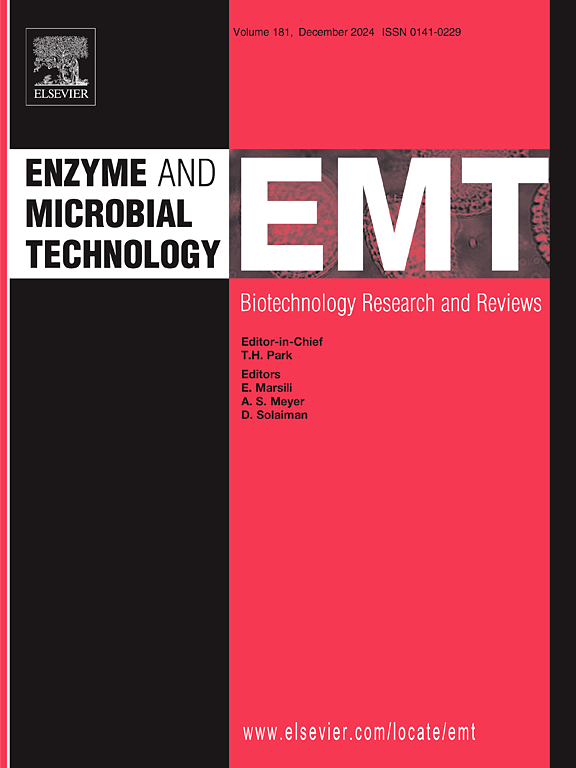A novel GH12 xyloglucanase from the white rot fungus Abortiporus biennis, synergistically enhances lignocellulose saccharification by commercial cellulases
IF 3.4
3区 生物学
Q2 BIOTECHNOLOGY & APPLIED MICROBIOLOGY
引用次数: 0
Abstract
Xyloglucan is a complex, highly substituted plant biomass polysaccharide, which is largely overlooked in the design of enzyme cocktails for lignocellulose saccharification, due to its presence in specific plant tissues only, and its low content. Thus, the microbial mechanisms for its degradation have not been thoroughly studied. However, in the frame of the biorefinery concept, xyloglucan monomers also have to be utilized for the design of efficient bioprocesses. Moreover, in plant tissues, xyloglucan often covers cellulose fibrils, impeding the access of cellulases. In order to shed light on the enzymatic degradation of xyloglucan, a novel GH12 family xyloglucanase was studied, from the basidiomycete Abortiporus biennis. The enzyme was heterologously produced in Pichia pastoris, purified and characterized. AbiXeg12a is a 28 kDa glycoprotein, with relatively strict substrate specificity, since it is only active in xyloglucan and β-glucan. The main hydrolysis products are the oligomers XXXG, XLXG/XXLG, XLLG and the optimum activity conditions are pH 4.5 and 55 °C. The enzyme contributes to the saccharification of corn bran and apple pulp by a commercial cellulase preparation, increasing the release of reducing sugars by up to 39 % and 18 %, respectively, while the addition of AbiXeg12a can minimize the enzyme load of the reaction, at least for apple pulp, without loss in reducing sugar yield. Overall, the importance of xyloglucanases on the saccharification of xyloglucan-containing substrates was demonstrated in this study. The results could contribute to the design of more efficient, tailor-made enzyme cocktails for the saccharification and subsequent valorization of lignocellulose.
一种新型GH12木葡聚糖酶从白腐真菌Abortiporus biennis中提取,协同增强了商用纤维素酶对木质纤维素的糖化作用
木葡聚糖是一种复杂的、高取代的植物生物质多糖,由于它只存在于特定的植物组织中,而且含量低,在设计木质纤维素糖化的鸡尾酒酶时,它在很大程度上被忽视了。因此,其降解的微生物机制尚未得到充分的研究。然而,在生物炼制概念的框架中,木葡聚糖单体也必须用于高效生物工艺的设计。此外,在植物组织中,木葡聚糖经常覆盖纤维素原纤维,阻碍纤维素酶的进入。为了阐明木葡聚糖的酶解作用,从担子菌Abortiporus biennis中研究了一种新的GH12家族木葡聚糖酶。该酶是在毕赤酵母中异源产生的,并进行了纯化和表征。AbiXeg12a是一个28 kDa的糖蛋白,具有相对严格的底物特异性,因为它只在木葡聚糖和β-葡聚糖中有活性。主要水解产物为低聚物XXXG、XLXG/XXLG、XLLG,最佳水解条件为pH 4.5和55 ℃。该酶有助于玉米皮和苹果果肉的糖化,分别增加高达39% %和18% %的还原糖的释放,而AbiXeg12a的加入可以最小化反应的酶负荷,至少对于苹果果肉,而不损失还原糖的产量。总之,本研究证明了木葡聚糖酶对含木葡聚糖底物糖化的重要性。研究结果有助于设计更有效的、量身定制的鸡尾酒酶,用于木质纤维素的糖化和随后的增值。
本文章由计算机程序翻译,如有差异,请以英文原文为准。
求助全文
约1分钟内获得全文
求助全文
来源期刊

Enzyme and Microbial Technology
生物-生物工程与应用微生物
CiteScore
7.60
自引率
5.90%
发文量
142
审稿时长
38 days
期刊介绍:
Enzyme and Microbial Technology is an international, peer-reviewed journal publishing original research and reviews, of biotechnological significance and novelty, on basic and applied aspects of the science and technology of processes involving the use of enzymes, micro-organisms, animal cells and plant cells.
We especially encourage submissions on:
Biocatalysis and the use of Directed Evolution in Synthetic Biology and Biotechnology
Biotechnological Production of New Bioactive Molecules, Biomaterials, Biopharmaceuticals, and Biofuels
New Imaging Techniques and Biosensors, especially as applicable to Healthcare and Systems Biology
New Biotechnological Approaches in Genomics, Proteomics and Metabolomics
Metabolic Engineering, Biomolecular Engineering and Nanobiotechnology
Manuscripts which report isolation, purification, immobilization or utilization of organisms or enzymes which are already well-described in the literature are not suitable for publication in EMT, unless their primary purpose is to report significant new findings or approaches which are of broad biotechnological importance. Similarly, manuscripts which report optimization studies on well-established processes are inappropriate. EMT does not accept papers dealing with mathematical modeling unless they report significant, new experimental data.
 求助内容:
求助内容: 应助结果提醒方式:
应助结果提醒方式:


